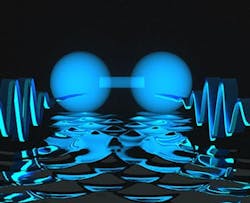Could scientists build molecules out of light only? Maybe …
A team including theoretical physicists from the National Institute of Standards and Technology (NIST; Boulder, CO) has taken another step toward building objects out of photons, and the findings hint that weightless particles of light can be joined into a sort of "molecule" with its own peculiar force.1
Related Article
The findings build on previous research that several team members contributed to before joining NIST.2 In 2013, collaborators from Harvard, Caltech, and MIT found a way to bind two photons together so that one would sit right atop the other, superimposed as they travel. Their experimental demonstration was considered a breakthrough, because no one had ever constructed anything by combining individual photons—inspiring some to imagine that real-life lightsabers were just around the corner.
Now, the NIST and University of Maryland-based team (with other collaborators) have shown theoretically that by tweaking a few parameters of the binding process, photons could travel side by side, a specific distance from each other. The arrangement is akin to the way that two hydrogen atoms sit next to each other in a hydrogen molecule.
"It's not a molecule per se, but you can imagine it as having a similar kind of structure," says NIST's Alexey Gorshkov. "We're learning how to build complex states of light that, in turn, can be built into more complex objects. This is the first time anyone has shown how to bind two photons a finite distance apart."
While the new findings appear to be a step in the right direction—if we can build a molecule of light, why not a sword?—Gorshkov says he is not optimistic that Jedi Knights will be lining up at NIST's gift shop anytime soon. The main reason is that binding photons requires extreme conditions difficult to produce with a roomful of lab equipment, let alone fit into a sword’s handle. Still, there are plenty of other reasons to make molecular light--humbler than lightsabers, but useful nonetheless.
"Lots of modern technologies are based on light, from communication technology to high-definition imaging," Gorshkov says. "Many of them would be greatly improved if we could engineer interactions between photons."
For example, engineers need a way to precisely calibrate light sensors, and Gorshkov says the findings could make it far easier to create a "standard candle" that shines a precise number of photons at a detector. Perhaps more significant to industry, binding and entangling photons could allow computers to use photons as information processors, a job that electronic switches in your computer do today.
Not only would this provide a new basis for creating computer technology, but it also could result in substantial energy savings. Phone messages and other data that currently travel as light beams through fiber optic cables has to be converted into electrons for processing—an inefficient step that wastes a great deal of electricity. If both the transport and the processing of the data could be done with photons directly, it could reduce these energy losses.
Gorshkov says it will be important to test the new theory in practice for these and other potential benefits. "It's a cool new way to study photons," he says. "They're massless and fly at the speed of light. Slowing them down and binding them may show us other things we didn't know about them before."
REFERENCES
1. F. Maghrebi et al., "Coulomb Bound States of Strongly Interacting Photons," Physical Review Letters, forthcoming (September 2015).
2. http://phys.org/news/2013-09-scientists-never-before-seen.html.
SOURCE: NIST; http://www.nist.gov/pml/div684/20150908lightsaber.cfm
About the Author

Gail Overton
Senior Editor (2004-2020)
Gail has more than 30 years of engineering, marketing, product management, and editorial experience in the photonics and optical communications industry. Before joining the staff at Laser Focus World in 2004, she held many product management and product marketing roles in the fiber-optics industry, most notably at Hughes (El Segundo, CA), GTE Labs (Waltham, MA), Corning (Corning, NY), Photon Kinetics (Beaverton, OR), and Newport Corporation (Irvine, CA). During her marketing career, Gail published articles in WDM Solutions and Sensors magazine and traveled internationally to conduct product and sales training. Gail received her BS degree in physics, with an emphasis in optics, from San Diego State University in San Diego, CA in May 1986.
